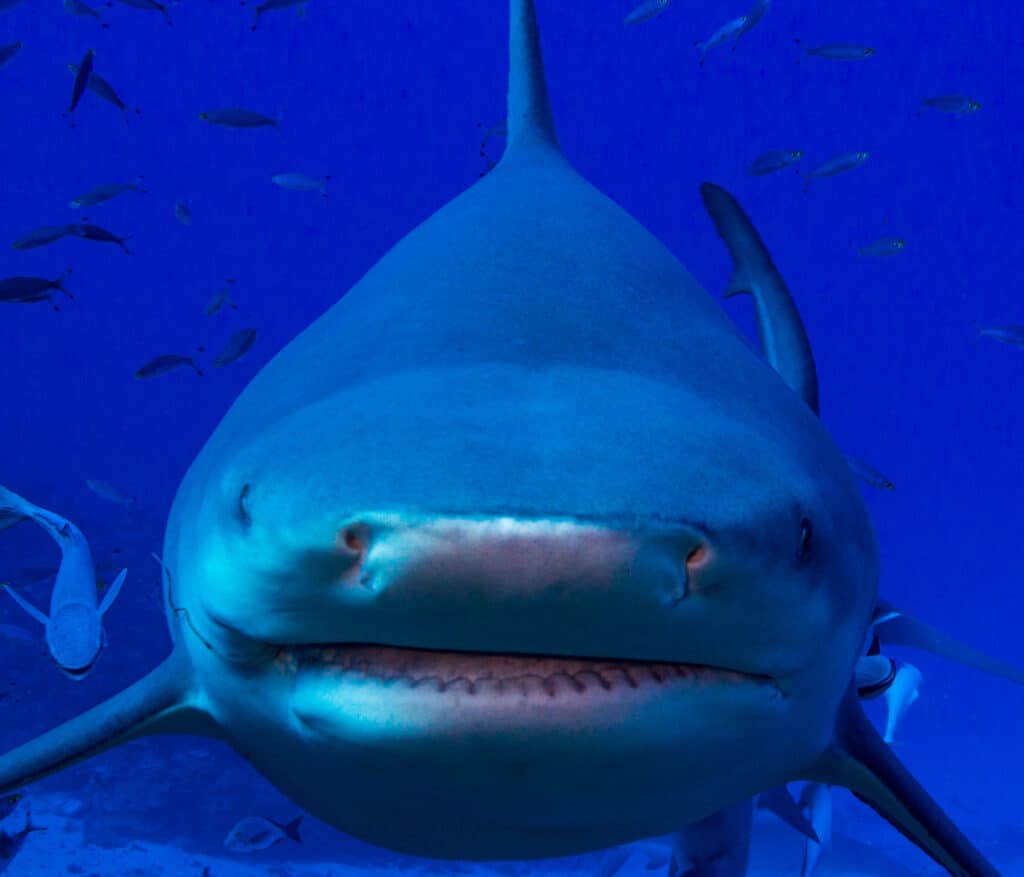
Bull sharks are often 7 feet in length.
©Michael Gomes/Shutterstock.com
Did you know there was one particular bull shark that is the largest one to date?
Bull sharks usually grow up to about 7 feet long. This behemoth was an impressive 10 feet long. But wait! Let us start from scratch, so you can discover the largest bull shark in full awe like it is supposed to be.
What Does a Bull Shark Look Like?
The physical appearance of the bull shark (Carcharhinus leucas) is somewhat similar to other great sharks. But there are some distinctive qualities. Here are just a few:
- The bull shark is gray in color with a white belly and dark tips on the fins. The dark tips are usually only found in juvenile sharks.
- Male sharks are usually smaller than females. While females grow 8 feet in length, the males pull up to a mere 7 feet.
- It has a small snout and a relatively longer caudal fin that is smaller in various other sharks.
- They have stout bodies due to their longer width-to-height ratio.
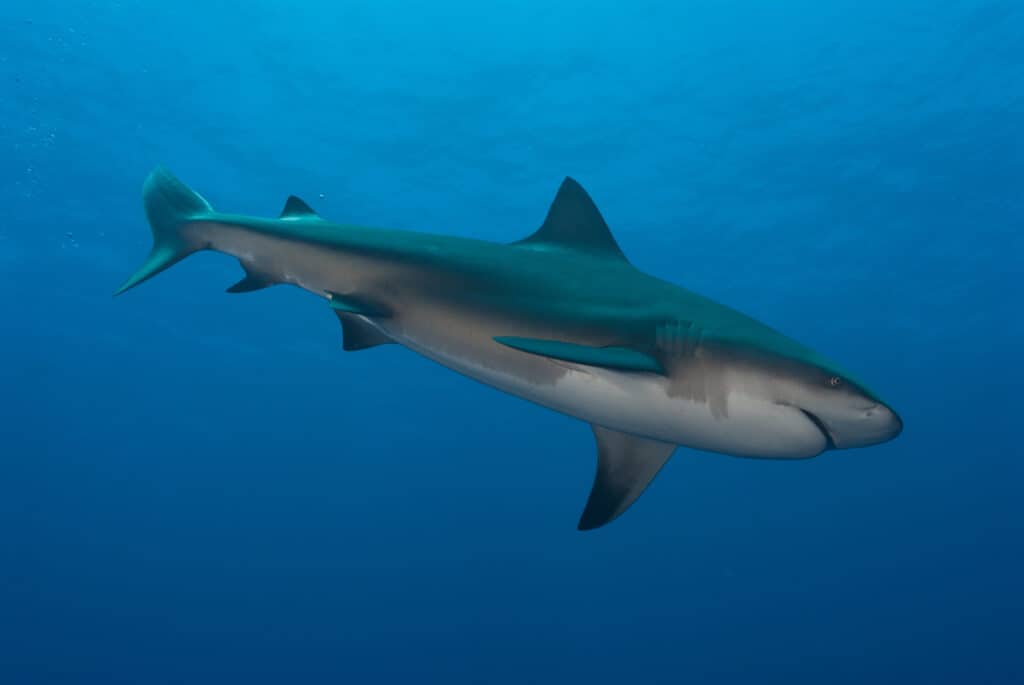
The bull shark is gray in color with a white belly and dark tips on the fins. Males grow to about 7 feet in extent.
©Fiona Ayerst/Shutterstock.com
Why Is It Called a Bull Shark?
They are aggressive with unpredictable behavior and have broad, flat snouts and stocky shapes. Add to that their hunting style, where they tend to head-butt their prey in an attempt to bring them down and these characteristics are why they are referred to as the bull shark.
Where Are Bull Sharks Found?
There are 43 different species of bull sharks found around the world. They tend to reside near the shore or are found deep in oceans. The species are distributed in the coastal areas of warm waters.
But the interesting thing about them is that they are seen swimming in both freshwater and saltwater coastal areas. They are one of the few sharks found in freshwater.

Lifespan of a Bull Shark
Bull sharks, like many others of the species, use estuarine nurseries for their young. Their actual lifespan may depend on their geographical region. They generally have a lifespan of around 16 years of age and are considered very resilient as they can thrive in a variety of different habitats. Females tend to live longer than males do and it is also not unheard of for them to live up to 25 years of age.
This shark is more at risk than others of its species because of the degradation of their habitats and pollution.
The Largest Bull Shark Ever Found
Now, let’s come to the bit you have been waiting to read. The average length of a bull shark extends to 8 feet maximum but the largest bull shark ever found was 10 feet long and weighed around 1,000 pounds. The weight is equivalent to four full-sized refrigerators while the length is equal to the height of a basketball hoop.
The discovery was made in 2012, by a group of researchers who were exploring and tagging sharks in Miami. When they came across this giant, they carried on with the same tagging process as they were doing with other sharks: tag it, take its blood, and samples of muscles and fin, then send it back into the ocean.
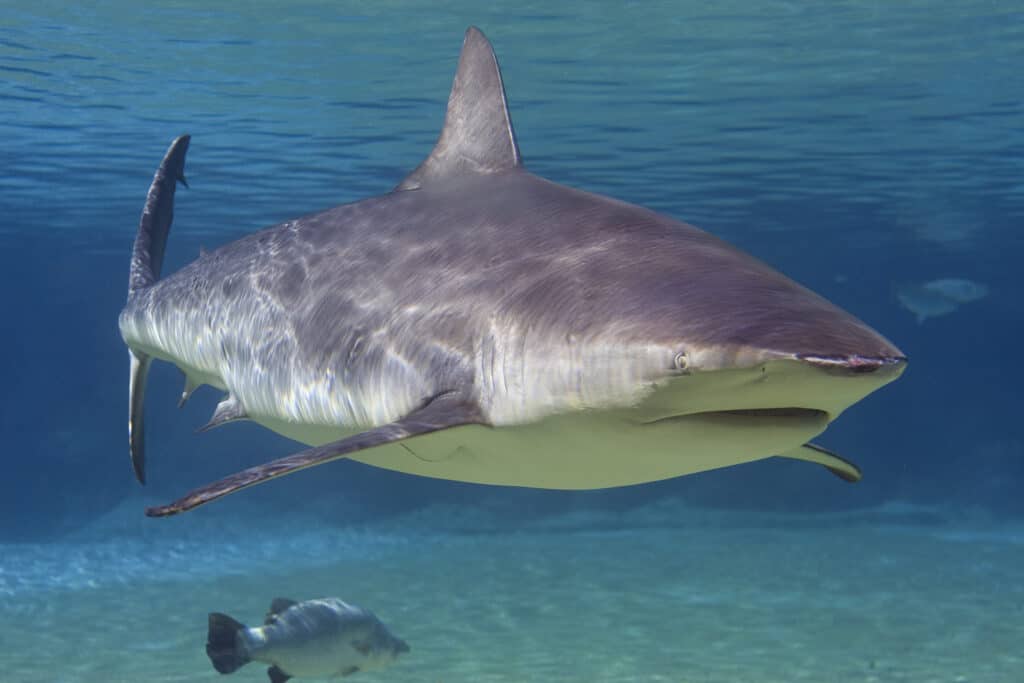
Bull sharks have broad, flat snouts and stock shapes.
©Ian Scott/Shutterstock.com
It was named Big Bull, which is just ferocious if you think about it. But the thing that startled the marine ecologists was its girth. It was humongous, looking like a wrestler with a huge body build and bulging neck.
Later on, when the Big Bull’s blood was put under observation, she was found to have recently given birth to babies. Then, a few years after this incident, three baby sharks of the same genetic material were found along the coastline.
This was another interesting turn of events because they hand-picked a baby shark that was related genetically to the same shark found a few years ago. And not just one, but three. This Big Bull had around 12 different babies that were all found in later years by different people.
A bull shark usually produces one to 13 babies in its reproductive cycle. But since Big Bull was one gigantic shark, it may have had lesser predators and higher mating cycles. But this does put one fact into concern — there might be such a small amount of gestating bull sharks, which may be the reason scientists only found a large number of babies descended from Big Bull itself.
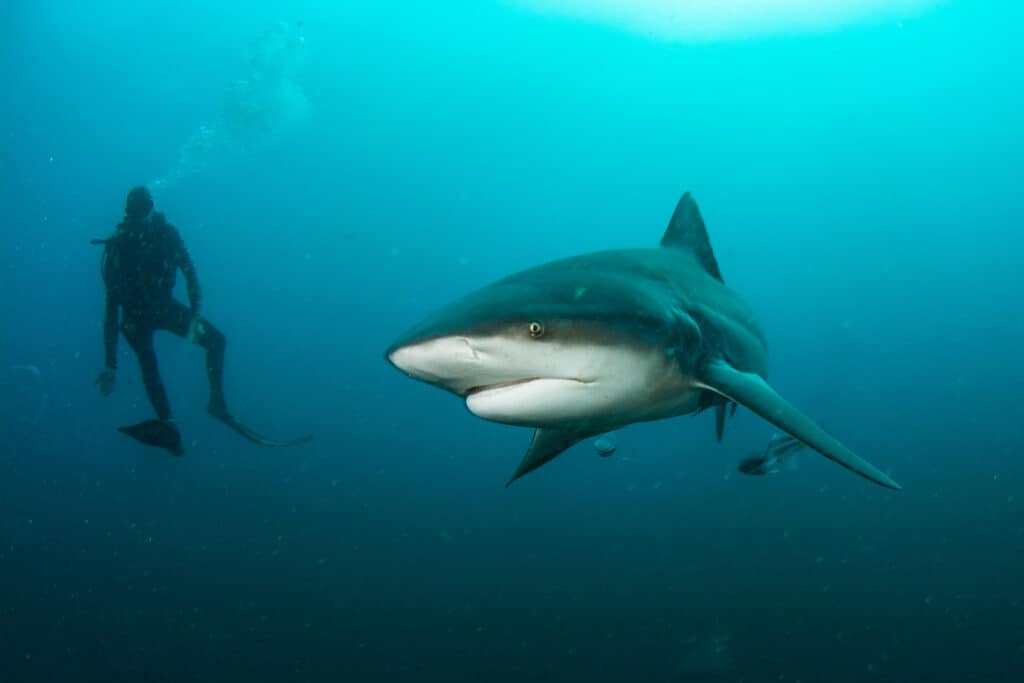
The biggest bull shark was so large its weight was the equivalent of four full-sized refrigerators.
©Stefan Pircher/Shutterstock.com
Does a Bull Shark Harm Humans?
They are known for their aggressive nature and are considered one of the most dangerous sharks in the world. The three main threats from the shark community to humans are the great white shark, the tiger shark, and the bull shark.
An estimate shows that bull sharks have attacked around 100 humans around the world. Out of this number, 27 people have been gravely injured.
Another thing about bull sharks is that they are found in rivers or lakes, and in places near populated areas. This increases the odds of people getting attacked by this large shark. In addition, it is found mainly in underdeveloped areas, making it hard to be identified and for the attacks to be immediately reported.
The question may be did Big Bull attack anyone? The first thing you should note is that the project handlers were shark experts. They know how to handle and catch a shark.
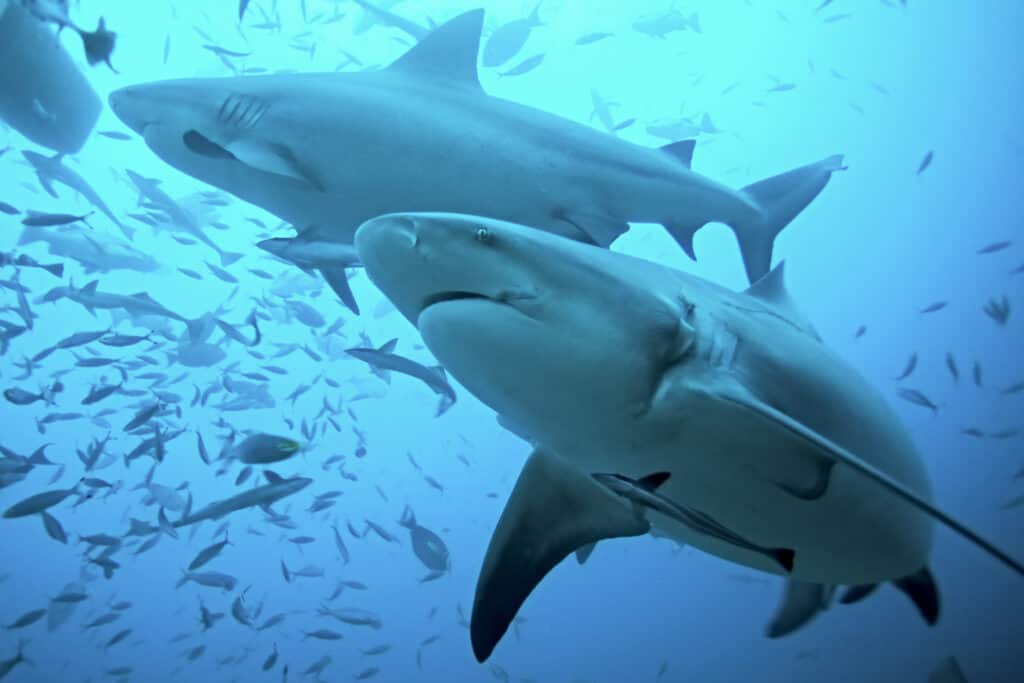
Bull sharks are quite often considered the most dangerous to humans because of their aggressive tendencies.
©Martin Prochazkacz/Shutterstock.com
Are Bull Sharks Threatened by Humans?
Yes, their species are considered near-threatened. Big Bull was one of the few reproductive females found. Then, the rest of the babies found also came from Big Bull.
It comes as no surprise that bull sharks are hunted like many other sharks. They are caught in huge numbers because of their presence in freshwater areas and near populated spaces. They are one of the few sharks entangled in the fishnets.
Their most popular part is the fins which are largely used in China as fin soup. Other than that, they are also hunted for meat, oils, and skins. It might not be a direct cause of their decreasing numbers but it plays a huge part in their lesser population size.
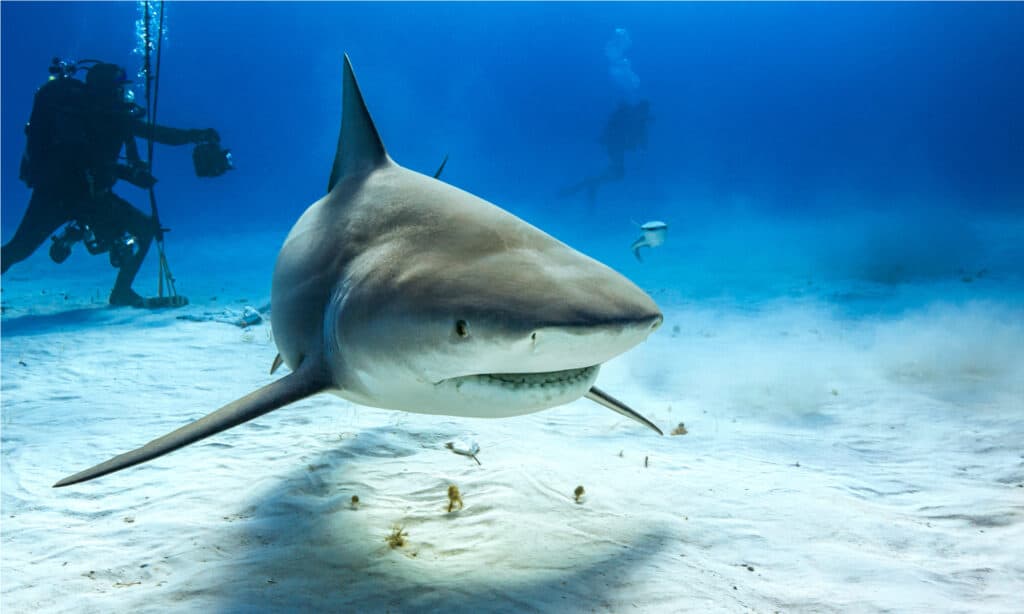
Bull sharks are under threat due to being poached for their fins.
©Carlos Grillo/Shutterstock.com
The photo featured at the top of this post is © HakBak/Shutterstock.com
Sources
- Wikipedia, Available here: https://en.wikipedia.org/wiki/Bull_shark#Anatomy_and_appearance
- University of Florida, Available here: https://www.floridamuseum.ufl.edu/discover-fish/species-profiles/carcharhinus-leucas/#:~:text=According%20to%20the%20International%20Game,was%20caught%20near%20Cairns%2C%20Australia.
- National Geographic, Available here: https://www.nationalgeographic.com/animals/article/offspring-of-one-of-worlds-biggest-bull-sharks-found
- CBS News, Available here: https://www.cbsnews.com/news/1000-pound-bull-shark-caught-by-researchers/
FAQs (Frequently Asked Questions)
Will bull sharks attack humans?
Why are bull sharks aggressive?
They are considered in this way for a multitude of reasons. First, bulls are undoubtedly aggressive, and they have to be in order to survive. Bull sharks are cannibalistic, eating younger bull sharks as well as other shark species. Being aggressive helps them survive before they become fully grown.
What eats a bull shark?
Adult bull sharks have few natural predators. Young bull sharks, however, can fall prey to tiger sharks (Galeocerdo cuvier), sandbar sharks (Carcharhinus plumbeus), and other Bull sharks. A crocodile in South Africa was also reported to have consumed a bull shark.
Thank you for reading! Have some feedback for us? Contact the AZ Animals editorial team.







